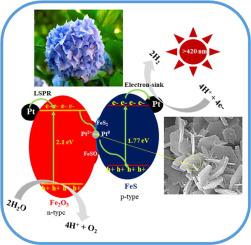当前位置:
X-MOL 学术
›
Appl. Surf. Sci.
›
论文详情
Our official English website, www.x-mol.net, welcomes your
feedback! (Note: you will need to create a separate account there.)
Visible light-induced stable HER performance using duality of ultrafine Pt NPs in a Z-scheme p-n junction Fe2O3@Pt@FeS catalyst
Applied Surface Science ( IF 6.3 ) Pub Date : 2021-03-01 , DOI: 10.1016/j.apsusc.2020.148347 Hyerim Park , Namgyu Son , Byung Hyun Park , Sang Woo Joo , Misook Kang
Applied Surface Science ( IF 6.3 ) Pub Date : 2021-03-01 , DOI: 10.1016/j.apsusc.2020.148347 Hyerim Park , Namgyu Son , Byung Hyun Park , Sang Woo Joo , Misook Kang

|
Abstract Developing the well-designed architecture is a marvel as new performance can be achieved even with trivial materials. In this study, we tried to maximize the photo-induced charge separation in a Pt decorated Z-scheme p-n junction Fe2O3/FeS photocatalytic system (Fe2O3@Pt@FeS), assembled by high dispersion of ultrafine Pt nanoparticles (NPs) of 10 nm between n-type Fe2O3 and p-type FeS particles. The Pt NPs attract or release the charges generated on the surface of both the particles, thereby leading to a longer interfacial movement of the charges, and in turn improving the catalytic activity. For the catalysts loaded with Pt NPs on single particles, the catalytic activities in hydrogen evolution reaction (HER) increase by two folds or more compared to those in the catalysts without Pt NPs. In the binary p-n junction Fe2O3/FeS catalyst, the hydrogen production performance significantly increased, and when Pt NPs of 0.01% are loaded thereon, the hydrogen production performance increase more than 30%. The localized surface plasmonic resonance (LSPR) effect and electron-sink ability of Pt NPs are confirmed by UV-visible absorption, XPS, H2-TPR, and EFM spectroscopies. Charge separation and recombination rates between electrons and holes on the Z-scheme p-n junction Fe2O3@Pt@FeS catalyst are evaluated by photoluminescence, photocurrent density, and IMPS/IMVS analysis. Eventually, the quantum efficiency on Fe2O3@Pt@FeS is approximately 5% at 527 nm, and it is maintained without catalytic deteriorating even after four regeneration processes.
中文翻译:

在 Z 型 pn 结 Fe2O3@Pt@FeS 催化剂中使用超细 Pt NPs 的二元性实现可见光诱导的稳定 HER 性能
摘要 开发精心设计的架构是一个奇迹,因为即使使用微不足道的材料也可以实现新的性能。在这项研究中,我们试图最大限度地提高 Pt 装饰的 Z 型 pn 结 Fe2O3/FeS 光催化系统 (Fe2O3@Pt@FeS) 中的光致电荷分离,该系统由 10 nm 的超细 Pt 纳米粒子 (NPs) 的高分散组装而成n 型 Fe2O3 和 p 型 FeS 颗粒之间。Pt NPs 吸引或释放两个粒子表面产生的电荷,从而导致电荷的界面运动更长,进而提高催化活性。对于在单个颗粒上负载 Pt NPs 的催化剂,与没有 Pt NPs 的催化剂相比,析氢反应 (HER) 的催化活性增加了两倍或更多。在二元 pn 结 Fe2O3/FeS 催化剂中,制氢性能显着提高,当负载0.01%的Pt NPs时,制氢性能提高30%以上。紫外可见吸收、XPS、H2-TPR 和 EFM 光谱证实了 Pt NPs 的局域表面等离子体共振 (LSPR) 效应和电子吸收能力。通过光致发光、光电流密度和 IMPS/IMVS 分析评估 Z 型 pn 结 Fe2O3@Pt@FeS 催化剂上电子和空穴之间的电荷分离和复合率。最终,Fe2O3@Pt@FeS 上的量子效率在 527 nm 处约为 5%,并且即使经过四次再生过程,它也不会催化劣化。制氢性能提高30%以上。紫外可见吸收、XPS、H2-TPR 和 EFM 光谱证实了 Pt NPs 的局域表面等离子体共振 (LSPR) 效应和电子吸收能力。通过光致发光、光电流密度和 IMPS/IMVS 分析评估 Z 型 pn 结 Fe2O3@Pt@FeS 催化剂上电子和空穴之间的电荷分离和复合率。最终,Fe2O3@Pt@FeS 上的量子效率在 527 nm 处约为 5%,并且即使经过四次再生过程,它也不会催化劣化。制氢性能提高30%以上。紫外可见吸收、XPS、H2-TPR 和 EFM 光谱证实了 Pt NPs 的局域表面等离子体共振 (LSPR) 效应和电子吸收能力。通过光致发光、光电流密度和 IMPS/IMVS 分析评估 Z 型 pn 结 Fe2O3@Pt@FeS 催化剂上电子和空穴之间的电荷分离和复合率。最终,Fe2O3@Pt@FeS 上的量子效率在 527 nm 处约为 5%,并且即使经过四次再生过程,它也不会催化劣化。通过光致发光、光电流密度和 IMPS/IMVS 分析评估 Z 型 pn 结 Fe2O3@Pt@FeS 催化剂上电子和空穴之间的电荷分离和复合率。最终,Fe2O3@Pt@FeS 上的量子效率在 527 nm 处约为 5%,并且即使经过四次再生过程,它也不会催化劣化。通过光致发光、光电流密度和 IMPS/IMVS 分析评估 Z 型 pn 结 Fe2O3@Pt@FeS 催化剂上电子和空穴之间的电荷分离和复合率。最终,Fe2O3@Pt@FeS 上的量子效率在 527 nm 处约为 5%,并且即使经过四次再生过程,它也不会催化劣化。
更新日期:2021-03-01
中文翻译:

在 Z 型 pn 结 Fe2O3@Pt@FeS 催化剂中使用超细 Pt NPs 的二元性实现可见光诱导的稳定 HER 性能
摘要 开发精心设计的架构是一个奇迹,因为即使使用微不足道的材料也可以实现新的性能。在这项研究中,我们试图最大限度地提高 Pt 装饰的 Z 型 pn 结 Fe2O3/FeS 光催化系统 (Fe2O3@Pt@FeS) 中的光致电荷分离,该系统由 10 nm 的超细 Pt 纳米粒子 (NPs) 的高分散组装而成n 型 Fe2O3 和 p 型 FeS 颗粒之间。Pt NPs 吸引或释放两个粒子表面产生的电荷,从而导致电荷的界面运动更长,进而提高催化活性。对于在单个颗粒上负载 Pt NPs 的催化剂,与没有 Pt NPs 的催化剂相比,析氢反应 (HER) 的催化活性增加了两倍或更多。在二元 pn 结 Fe2O3/FeS 催化剂中,制氢性能显着提高,当负载0.01%的Pt NPs时,制氢性能提高30%以上。紫外可见吸收、XPS、H2-TPR 和 EFM 光谱证实了 Pt NPs 的局域表面等离子体共振 (LSPR) 效应和电子吸收能力。通过光致发光、光电流密度和 IMPS/IMVS 分析评估 Z 型 pn 结 Fe2O3@Pt@FeS 催化剂上电子和空穴之间的电荷分离和复合率。最终,Fe2O3@Pt@FeS 上的量子效率在 527 nm 处约为 5%,并且即使经过四次再生过程,它也不会催化劣化。制氢性能提高30%以上。紫外可见吸收、XPS、H2-TPR 和 EFM 光谱证实了 Pt NPs 的局域表面等离子体共振 (LSPR) 效应和电子吸收能力。通过光致发光、光电流密度和 IMPS/IMVS 分析评估 Z 型 pn 结 Fe2O3@Pt@FeS 催化剂上电子和空穴之间的电荷分离和复合率。最终,Fe2O3@Pt@FeS 上的量子效率在 527 nm 处约为 5%,并且即使经过四次再生过程,它也不会催化劣化。制氢性能提高30%以上。紫外可见吸收、XPS、H2-TPR 和 EFM 光谱证实了 Pt NPs 的局域表面等离子体共振 (LSPR) 效应和电子吸收能力。通过光致发光、光电流密度和 IMPS/IMVS 分析评估 Z 型 pn 结 Fe2O3@Pt@FeS 催化剂上电子和空穴之间的电荷分离和复合率。最终,Fe2O3@Pt@FeS 上的量子效率在 527 nm 处约为 5%,并且即使经过四次再生过程,它也不会催化劣化。通过光致发光、光电流密度和 IMPS/IMVS 分析评估 Z 型 pn 结 Fe2O3@Pt@FeS 催化剂上电子和空穴之间的电荷分离和复合率。最终,Fe2O3@Pt@FeS 上的量子效率在 527 nm 处约为 5%,并且即使经过四次再生过程,它也不会催化劣化。通过光致发光、光电流密度和 IMPS/IMVS 分析评估 Z 型 pn 结 Fe2O3@Pt@FeS 催化剂上电子和空穴之间的电荷分离和复合率。最终,Fe2O3@Pt@FeS 上的量子效率在 527 nm 处约为 5%,并且即使经过四次再生过程,它也不会催化劣化。











































 京公网安备 11010802027423号
京公网安备 11010802027423号